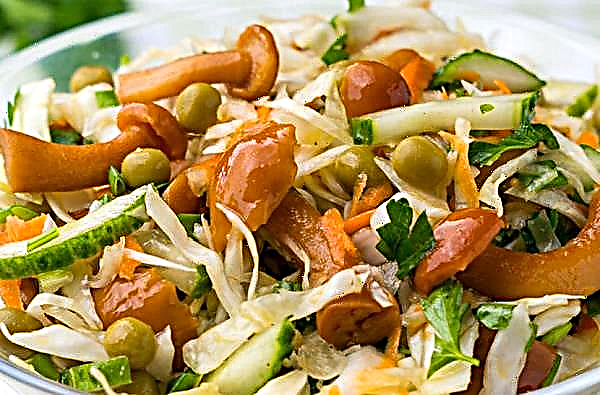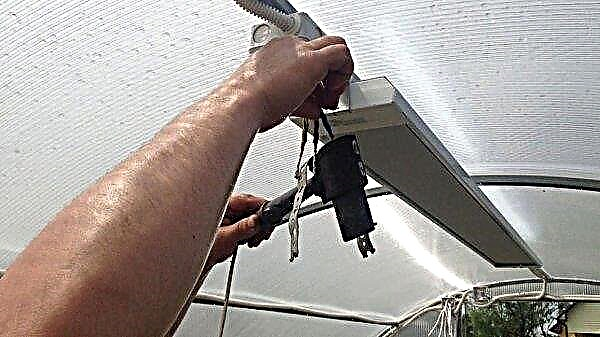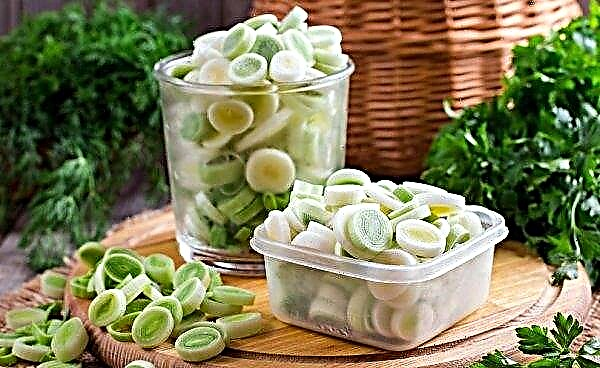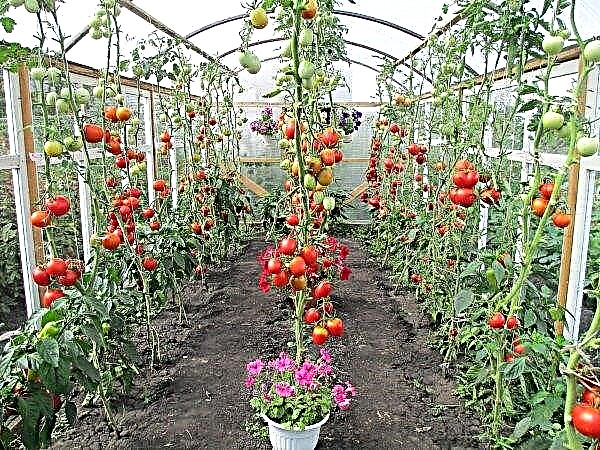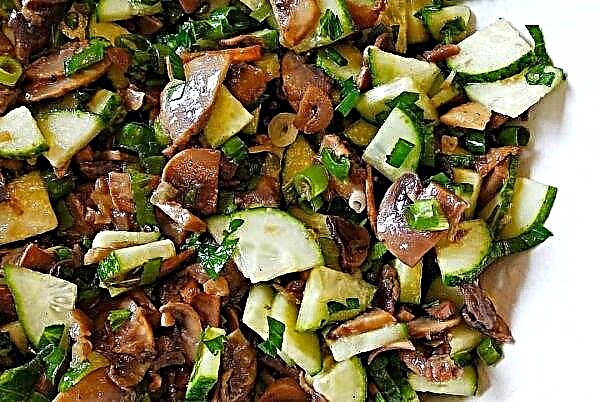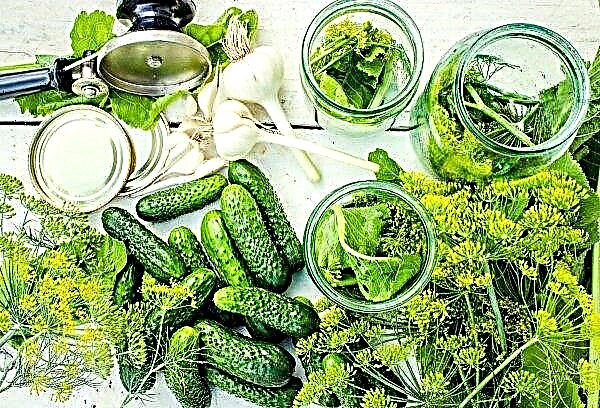Caramel tomatoes belong to cherry tomatoes - small fruits with a rich taste. In this article you will learn about the qualities that this variety has gained the trust of gardeners, how to grow tomatoes properly and what rules for care they need.
History of Variety Breeding
Variety Caramel F1 is a hybrid bred by Russian breeders. Since the variety is hybrid, tomatoes must be grown annually from scratch, and it will not work to grow bushes from seeds of the previous crop.
The hybrid has varieties, among which one can distinguish Caramel red, yellow and honey. The difference between them lies solely in the color of the fetus.
Characterization and description of the variety
Before growing Caramel on its site, it is worth familiarizing yourself with all the characteristics of the variety and its features, thanks to which tomatoes have gained their popularity among gardeners.
Did you know? In the world there are at least 10 thousand varieties of tomato.
Productivity
One of the advantages of Caramel is its high yield. Bushes with ripe tomatoes resemble grapes, and on one such "cluster" grows from 30 to 50 fruits. And with careful care of the bushes from one square meter, you can collect about 4 or more kg of tomatoes.
Description of the fetus
Tomatoes of this variety are small in size - about 3 cm in diameter and weighing 30 g. Their shape is elliptical or plum-like. The fruit is inherent in the presence of juicy pulp and a dense, fairly stiff skin. The skin color varies from rich red to yellow and yellow-orange, depending on the variety variety you have chosen.
The taste characteristics of Caramel correspond to its name - the tomatoes are sweet, may have a slight acidity. At the same time, the fruits are widely used in cooking: tomatoes are consumed fresh, canned, used for the preparation of salads, snacks and as an edible decoration.
Advantages and disadvantages of the variety
Caramel has a number of positive qualities, due to which the hybrid is widely used.
- Among them it is worth highlighting:
- early ripening of fruits;
- high yields;
- long term fruiting;
- resistance of tomatoes to cold and shade of the site;
- resistance to diseases inherent in tomatoes;
- versatility for use in cooking;
- palatability of fruits;
- convenience in transportation.
However, to understand whether this tomato variety is suitable for you, it is advisable to familiarize yourself not only with its advantages, but also learn about the shortcomings.
- These include:
- the need to form a bush;
- the hybrid's exactingness to growing conditions - the support must be strong;
- stiffness of the skin of the fruit.

Acceptable timing for growing
To grow caramel tomatoes on your plot, you do not need a lot of knowledge and skills - just follow the step-by-step instructions that you will find below.
As for the terms, it is preferable to sow the seeds in special containers (they are also called tablets) after the third week of March, that is, after about the 21st day.
The basic rules for growing Caramel F1
Even a beginner gardener will cope with the cultivation of this hybrid. All you need is seeds, free time and instructions that show all the nuances of growing caramel tomatoes.
Growing seedlings
The first thing you should start with is sowing seeds in special containers for seedlings. There, the seeds will develop before germination.
Gardeners themselves often process seeds with disinfectants. It is not necessary to process caramel with such a tool, but the use of growth stimulants will help increase the amount of yield obtained from seeds.
Important! The air temperature in the room with seedlings should be kept within + 23 ° С. This is the main condition under which seeds can actively develop.
It is necessary to place garden soil mixed with humus and vermiculite in a container for seedlings. Then place the seeds there and sprinkle with soil on top. Immediately after sowing, you need to water the future tomatoes abundantly and place under a plastic film. After the seeds in the containers germinate, the film should be removed and the seedlings removed in a cooler, but at the same time well-lit place.
After the seeds in the containers germinate, the film should be removed and the seedlings removed in a cooler, but at the same time well-lit place.
The appearance of two true leaves on seedlings is a sign that the plants need to be planted in separate small containers or leave them in one large container, but increase the distance between the seedlings.
This procedure is also called diving.
Preparation of a plot for planting seedlings
Landing of planting material is carried out in the second half or end of May. You should focus on the climate inherent in your area. An important condition for planting tomatoes is the lack of the possibility of repeated frosts, since plants may not survive the temperature difference.
On the eve of planting, you also need to make sure that the soil has warmed well enough.
Seedling Planting Technology
In the soil, it is necessary to build small holes in which a handful of wood ash and a spoonful of complex mineral fertilizers are also poured before planting tomatoes. Then a seedling is placed in the same hole.
Important! On a plot of one square. meter should be placed no more than three bushes. A greater number of them will negatively affect the yield, since plants will receive less nutrients from the soil.
If the seedlings quickly extended upward, the seedlings should be placed in the hole so that 2-3 cm of the bush remains on the surface. After planting seedlings, the soil must be poured with warm water.
Crop care
At planting seedlings, the need to care for the plant does not end. In order for tomatoes to please you with delicious fruits, it is worth remembering the rules for caring for the plant and observing them. The more carefully you monitor the health of plants, the more likely it is to get a high yield.
Watering Rules
Caramel tomatoes are not too demanding on the conditions of irrigation, but there are rules thanks to which the plant will develop better. So, you need to water the bushes with warm water. To do this, you need to dial water in advance in a large container - a barrel or container, and only after it has been heated can you water the tomatoes.
Important! The leaves of this variety are quite sensitive - the water that has got on them and heated from the sun can burn the plant. For this reason, watering Caramel is recommended in the evening.
It is also advisable to avoid getting liquid on the leaves of the bushes and direct the flow of water under the very root of the plant. The frequency of watering depends on how quickly the top of the soil dries. Plants should be watered when the ground becomes dry at a depth of 2-3 cm.
Top dressing
Fertilize tomatoes during the growth period twice a month with an interval of two weeks. As a top dressing, it is advisable to turn to organic fertilizers, among which cow or bird droppings can be distinguished. Organic fertilizer should be diluted with water at the rate of 1 kg of fertilizer per 1 bucket of water.
The resulting solution and you need to water the bushes. You can also add complex organic fertilizers to organic substances and feed them with plants according to the instructions.
Pasynkovka and formation of a bush
The stepsoning procedure is necessary, and it is carried out as the bush grows. Those stalks on which the ovary did not form are stepsoned. At the same time, it is important to ensure that at least two large stems remain on one bush.
Important! In the case of rapid growth of the bush, trellises or another strong support should be used, thanks to which the tomatoes will not subsequently break under the weight of the fruit.
To stop the active growth of the bush, you should resort to pinching the upper point of the plant, due to which the bush receives enough ultraviolet light, forms an ovary. The same point contributes to the ripening of the crop.
Soil cultivation and weeding
Weeding the soil is the most convenient way to get rid of weeds, so you should not neglect this stage of plant care. Loosening the soil is also necessary - such a treatment procedure will saturate the soil with oxygen, which has a beneficial effect on the development of the tomato bush. Weeding should be done carefully so as not to touch the roots of the bushes. Injury to the stem or roots can cause hybrid disease. In particular, the infection is brought not by the fact of injury, but by injury by contaminated and untreated garden tools.
Weeding should be done carefully so as not to touch the roots of the bushes. Injury to the stem or roots can cause hybrid disease. In particular, the infection is brought not by the fact of injury, but by injury by contaminated and untreated garden tools.
Pests and diseases of the variety
This tomato variety is resistant to diseases typical of the culture, namely phytophthora, fusarium and tobacco mosaic. However, in order to protect the plant from other possible diseases, it is highly recommended that preventive measures be taken.
These include cleaning the site of weeds that absorb nutrients, thereby taking vitamins and minerals from the tomato bush. It is also worth processing tomatoes with anti-fungal agents. One of these is Fitosporin.
Tomatoes can protect against pest attacks by such home methods as processing bushes with chamomile or celandine infusion. To save tomatoes from the invasion of pests, bushes should be treated with insecticides according to the instructions.
Harvesting and storage rules
Harvesting is necessary before the ambient temperature drops to + 8 ° C. Attention should be paid to fruits that have acquired a saturated color - red, yellow or yellow-orange. Ripe fruits should be removed from the bush, and then placed in boxes in a trellised lid. It is advisable to lay paper at the bottom of the drawer. In the box with tomatoes, you can pour chips made of leaves. It is advisable that the humidity in the room be at least 65%. Due to the high humidity, the crop retains its taste and does not dry out.
It is advisable to lay paper at the bottom of the drawer. In the box with tomatoes, you can pour chips made of leaves. It is advisable that the humidity in the room be at least 65%. Due to the high humidity, the crop retains its taste and does not dry out.
Long-term storage of tomatoes in the refrigerator is not recommended, as this adversely affects the taste of the fruit.
Did you know? In order for the tomato to be saturated again with taste, it is enough to leave it for several hours in a room with room air temperature.
Summing up, we can say that Caramel tomatoes are suitable for both experienced gardeners and beginners. This hybrid is not too capricious, caring for it only complicates the need for the formation of bushes, and the taste of the crop allows the fruits to be used both fresh and after heat treatment or for conservation.


